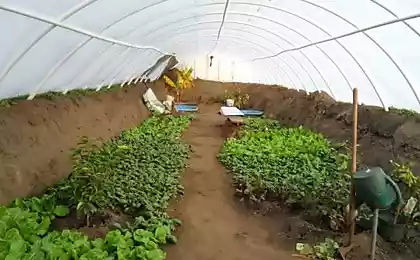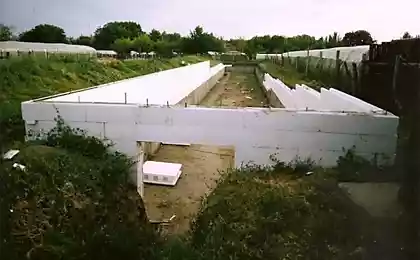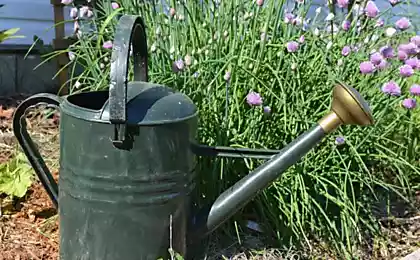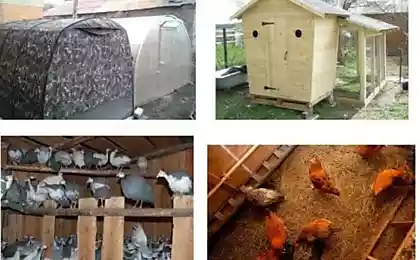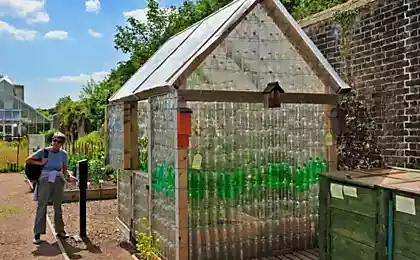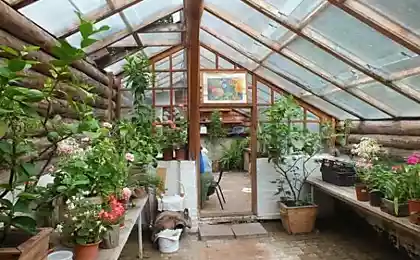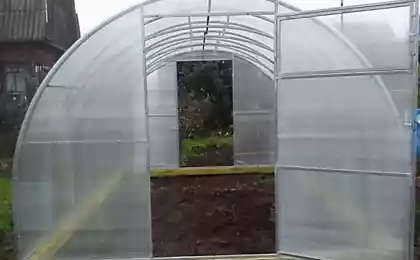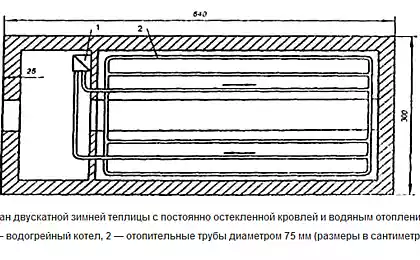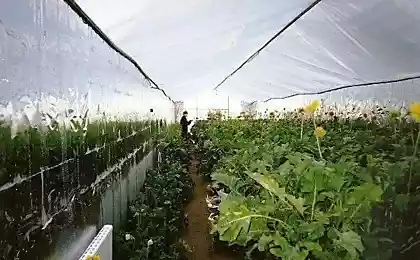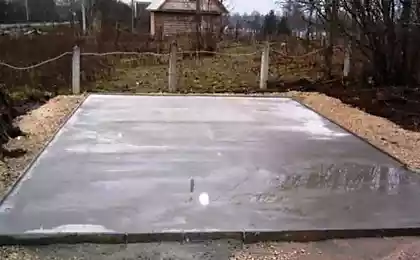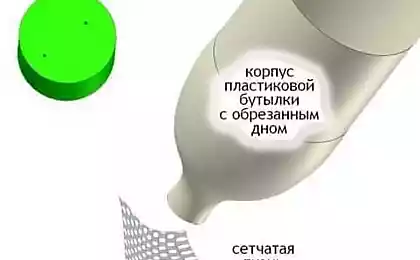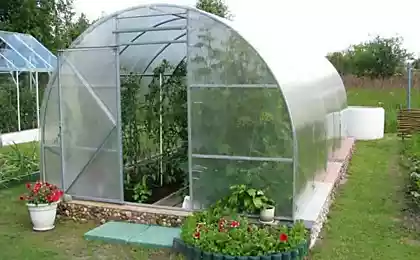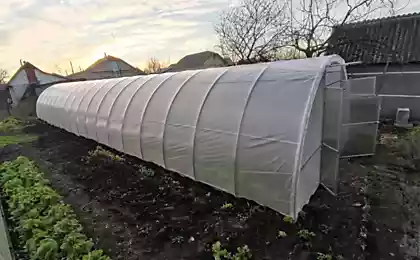616
How to make a watering system for greenhouses
When growing seedlings of vegetable cultures and flowers in the enclosed from natural precipitation conditions, special significance is attached to the watering system for the greenhouse. It ensures the supply of water to the roots of the plants can increase air humidity, reduce the temperature of the room in the most sultry day, to participate in the introduction of nutrients and minerals. Depending on the size of irrigated area, planted vegetation, climate, and soil characteristics are different irrigation methods.
Types of irrigation systems and their design features depending on the needs of plants in moisture and soil composition, there are several ways of irrigation management, wherein the method of supplying water. In parallel, it is possible to organize irrigation system two or more greenhouses.
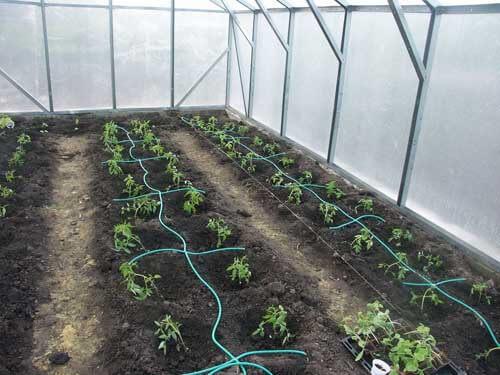
Installing irrigation is a simple and effective design
This method is an artificial rain is produced by spraying water and formed the complex of equipment: a pump; a distributing pipe or garden hose; injector nozzles. For closed conditions best suited upper irrigation. The wiring with the injectors mounted higher to increase the range of irrigation from the same source. Requirements to water quality did not show, as the opening in the dispensers is large enough to become clogged.
Make it personally is quite simple. Install and connect to power supply the pump with pressure not less than 0.25 MPa, the required height lay plastic tubes or fixed on metal rails garden hoses with built-in nozzles-sprinklers. If you want to achieve a fine spray, choose a nozzle with a smaller diameter, but it may require the installation of the filter.
Pump performance select based on the needs of crops and soil type the heavier the soil, the less water required to hydrate the basal layer.
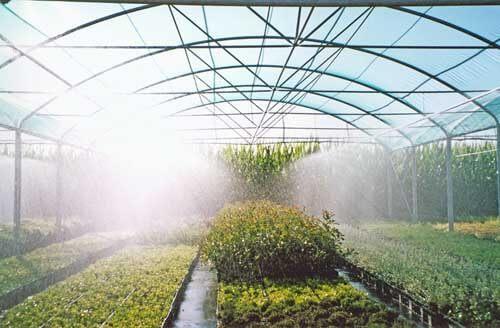
Double-line top irrigation Subsurface irrigation is ideal to control humidity of soil and air
Some plants (xerophilous) do not tolerate high humidity and appropriate for them to organize in a greenhouse subsurface irrigation and, if necessary, humidifying the air to use a separate installation, for example, foggers. Underground irrigation system is a distributing perforated thick-walled hoses or pipes, laid at a distance of 0.5–0.9 m from each other and connected to the pump or accumulator.
Such a system of watering in the greenhouse easy to do with their hands. To do this, dig trenches to a depth of about 25 cm and cover them with plastic wrap. If you do not purchase a perforated hose in the plastic or metal pipe every 0,3–0,4 m drill holes – four of them aimed in different directions.
Holes can be round, with a diameter of about 2-3 mm or slotted section of 10x2 mm. the pipe End cap. The prepared pipe is laid in the trench with a slight slope from the pump (to displace air), connect them to the network and connect to water source.
For easy control of on / off switching of the pressurizing equipment can be automated. Control unit buy or do yourself. To estimate the optimal activation time is possible wet spots on the surface. Note the time and set a timer.
Before planting seeds or seedlings collected design testing during the week, and then opened the ground in several places, evaluate the quality and uniformity of hydration, regulate, and again covered with soil.

Drip irrigation for greenhouse conditions and open field, drip irrigation system for greenhouses can be assembled from perforated thin-walled tubes-tapes, or tubing with drippers of different designs. Drops watering is carried out at low pressure of water, so it is well suited for low pressure networks. At high pressure, set the buck regulator. This method is ideal for multi-tier shelving, such as garden strawberry, and normal landing.
The drip pipes can be built-in and external. Pipes with built in drippers buy ready-made, and with the outer can be done independently of the individual elements. The easiest way to assemble a network of perforated tapes.
This tube is placed on the soil along the beds, break, close one end and the other attached through the start-up fittings to a manifold out of PVC pipe. Pressure tank storage is mounted on the height 1.5–2.5 m, and embed it in the main pipe with the necessary fittings: a tap and a filter. This is just one example of how to do drip irrigation in the greenhouse. With your hands you can also make and system with droppers. For large networks it is advisable to automate watering, installing the controller after the filter.
Drip irrigation saves water, as it is targeted and controlled hydration of individual plants. It is convenient to combine with the introduction of multi-component fertilizers (phosphorus, nitrogen, potassium). For this line of mortar is inserted into the node on the basis of three dosing pumps, each of which submits a solution to one element. This construction does not occur crystallization and precipitation of elements in the sediment, and the plants absorb all the nutrients.
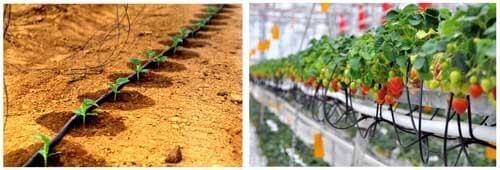
Process automation and additional methods for increasing the yield
To increase productivity and reduce labor costs, additionally, use the following methods:
In the hot season the temperature in a closed greenhouse increases to a critical level. Automatic fogging system is able to humidify the air and at the same time lowering its temperature, and the maximum achievable value of lowering the temperature is 18-20 grams.
Set humanoperator every 2.5–3 m. an Automatic water injection put up for 10-15 seconds. Included watering mist 1-3 times per hour. This is enough to make the atmosphere comfortable for the plants. Water is pumped through a cascade of filters, and consumes very sparingly.

Scheme of the formation of fog
Ventilation is another method of control of temperature and humidity
To reduce the temperature and humidity, you can use ventilation. The process has not depended on the presence of a person, it is better to automate. On sale is a ready position, but their purchase is suitable only for semi-industrial agriculture. On a country site it is possible to build Autonomous ventilation.
There are some proven methods:
Automation of processes – reducing labor costs and saving water resources
If the area of the greenhouse is large enough, the optimal solution is to install a automatic watering system in the greenhouse. To do this, acquire controllers, timers, control units. It is important to choose the model that combines all the necessary features: adjustable pressure, automatic on and off, lock, programmable for different period.
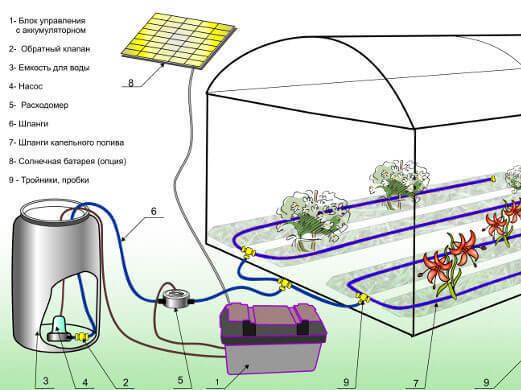
The automatic irrigation system Automatic watering system in the greenhouse can be done with your own hands, using simple devices, or order the whole complex of the equipment specialized organization. The last is most appropriate for large area irrigation. How to set a timer for drip irrigation for distributing water look at the video:
published
P. S. And remember, only by changing their consumption — together we change the world! ©
Join us in Facebook , Vkontakte, Odnoklassniki
Source: 101dizain.com/ustrojstvo/poliv/sistema-poliva-dlya-teplicy.html
Types of irrigation systems and their design features depending on the needs of plants in moisture and soil composition, there are several ways of irrigation management, wherein the method of supplying water. In parallel, it is possible to organize irrigation system two or more greenhouses.

Installing irrigation is a simple and effective design
This method is an artificial rain is produced by spraying water and formed the complex of equipment: a pump; a distributing pipe or garden hose; injector nozzles. For closed conditions best suited upper irrigation. The wiring with the injectors mounted higher to increase the range of irrigation from the same source. Requirements to water quality did not show, as the opening in the dispensers is large enough to become clogged.
Make it personally is quite simple. Install and connect to power supply the pump with pressure not less than 0.25 MPa, the required height lay plastic tubes or fixed on metal rails garden hoses with built-in nozzles-sprinklers. If you want to achieve a fine spray, choose a nozzle with a smaller diameter, but it may require the installation of the filter.
Pump performance select based on the needs of crops and soil type the heavier the soil, the less water required to hydrate the basal layer.

Double-line top irrigation Subsurface irrigation is ideal to control humidity of soil and air
Some plants (xerophilous) do not tolerate high humidity and appropriate for them to organize in a greenhouse subsurface irrigation and, if necessary, humidifying the air to use a separate installation, for example, foggers. Underground irrigation system is a distributing perforated thick-walled hoses or pipes, laid at a distance of 0.5–0.9 m from each other and connected to the pump or accumulator.
Such a system of watering in the greenhouse easy to do with their hands. To do this, dig trenches to a depth of about 25 cm and cover them with plastic wrap. If you do not purchase a perforated hose in the plastic or metal pipe every 0,3–0,4 m drill holes – four of them aimed in different directions.
Holes can be round, with a diameter of about 2-3 mm or slotted section of 10x2 mm. the pipe End cap. The prepared pipe is laid in the trench with a slight slope from the pump (to displace air), connect them to the network and connect to water source.
For easy control of on / off switching of the pressurizing equipment can be automated. Control unit buy or do yourself. To estimate the optimal activation time is possible wet spots on the surface. Note the time and set a timer.
Before planting seeds or seedlings collected design testing during the week, and then opened the ground in several places, evaluate the quality and uniformity of hydration, regulate, and again covered with soil.

Drip irrigation for greenhouse conditions and open field, drip irrigation system for greenhouses can be assembled from perforated thin-walled tubes-tapes, or tubing with drippers of different designs. Drops watering is carried out at low pressure of water, so it is well suited for low pressure networks. At high pressure, set the buck regulator. This method is ideal for multi-tier shelving, such as garden strawberry, and normal landing.
The drip pipes can be built-in and external. Pipes with built in drippers buy ready-made, and with the outer can be done independently of the individual elements. The easiest way to assemble a network of perforated tapes.
This tube is placed on the soil along the beds, break, close one end and the other attached through the start-up fittings to a manifold out of PVC pipe. Pressure tank storage is mounted on the height 1.5–2.5 m, and embed it in the main pipe with the necessary fittings: a tap and a filter. This is just one example of how to do drip irrigation in the greenhouse. With your hands you can also make and system with droppers. For large networks it is advisable to automate watering, installing the controller after the filter.
Drip irrigation saves water, as it is targeted and controlled hydration of individual plants. It is convenient to combine with the introduction of multi-component fertilizers (phosphorus, nitrogen, potassium). For this line of mortar is inserted into the node on the basis of three dosing pumps, each of which submits a solution to one element. This construction does not occur crystallization and precipitation of elements in the sediment, and the plants absorb all the nutrients.

Process automation and additional methods for increasing the yield
To increase productivity and reduce labor costs, additionally, use the following methods:
- automation;
- the foggers;
- ventilation.
In the hot season the temperature in a closed greenhouse increases to a critical level. Automatic fogging system is able to humidify the air and at the same time lowering its temperature, and the maximum achievable value of lowering the temperature is 18-20 grams.
Set humanoperator every 2.5–3 m. an Automatic water injection put up for 10-15 seconds. Included watering mist 1-3 times per hour. This is enough to make the atmosphere comfortable for the plants. Water is pumped through a cascade of filters, and consumes very sparingly.

Scheme of the formation of fog
Ventilation is another method of control of temperature and humidity
To reduce the temperature and humidity, you can use ventilation. The process has not depended on the presence of a person, it is better to automate. On sale is a ready position, but their purchase is suitable only for semi-industrial agriculture. On a country site it is possible to build Autonomous ventilation.
There are some proven methods:
- with the ejector – bimetal strip;
- shimmering vessels due to the expansion of the liquid;
- using a piston-cylinder – due to the expansion of air.
Automation of processes – reducing labor costs and saving water resources
If the area of the greenhouse is large enough, the optimal solution is to install a automatic watering system in the greenhouse. To do this, acquire controllers, timers, control units. It is important to choose the model that combines all the necessary features: adjustable pressure, automatic on and off, lock, programmable for different period.

The automatic irrigation system Automatic watering system in the greenhouse can be done with your own hands, using simple devices, or order the whole complex of the equipment specialized organization. The last is most appropriate for large area irrigation. How to set a timer for drip irrigation for distributing water look at the video:
published
P. S. And remember, only by changing their consumption — together we change the world! ©
Join us in Facebook , Vkontakte, Odnoklassniki
Source: 101dizain.com/ustrojstvo/poliv/sistema-poliva-dlya-teplicy.html
